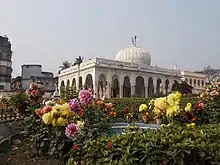Calcutta Jain Temple
Calcutta Jain Temple (also called Parshwanath Temple) is a Jain temple at Badridas Temple Street, Gouribari in Maniktala and a major tourist attraction of Kolkata (Calcutta), India. The temple was built by a Jain named Rai Badridas Bahadoor Mookim in 1867. Pratishtha was done by Sri Kalyansurishwarji Maharaj.[1][2][3]
| Calcutta Jain Temple | |
|---|---|
 | |
| Religion | |
| Affiliation | Jainism |
| Deity | Parshvanatha |
| Festivals | Mahavir Jayanti, Paryushan |
| Location | |
| Location | Gouribari, Maniktala, Kolkata, West Bengal |
| Architecture | |
| Creator | Rai Badridas Bahadoor Mookim |
| Date established | 1867 |
| Temple(s) | 5 |
| Part of a series on |
| Jainism |
|---|
 |
|
|
About Temple
The complex is subdivided into 4 temples:
- Shitalnath Ji Temple : Mulnayak : Shitalnath Bhagwan.
- Chandraprabhu Ji temple : Mulnayak : Chandraprabhuswami Bhagwan.
- Mahavir Swami Temple : Mulnayak : Sri Mahavir Swami.
- Dadawadi : Footprints of Jain Acharya Jin Dutt Kushal Suri.

The temple is dedicated to Parshwanath, who was the 23rd Jain Tirthankar and he is worshipped by the Jains. This is one of the most important Jain temples in Kolkata. The place is famous all over that is why devout Jains from distant parts of India flock to the Temple precincts all round the year. The temple consists of four temples inside of it. The deity of Lord Shitalnathji is seated in the sanctum sanctorum and his diamond-studded forehead is a major attraction for the visitors. There is a lamp, which burns with ghee inside the sanctum sanctorum, which has been continuously burning ever since the initiation of the temple since 1867. The lamp bears silent testimony to the contemporary world since ages and it is wonderful to acknowledge the mysticism associated with.
There are three other shrines dedicated to Chanda Prabhujidev, Dadagarudev Shri Jin Kushal Suriji Maharaj. The last temple is dedicated to Lord Mahaveera, who was the last Tirthankara of the Jain tradition.
Pareshnath Jain Temple, Kolkata has displays of exquisite designs and it is an impressive structure consisting of mirror-inlaid pillars and windows that have made of stained glass. The interiors of the temple are splendidly beautiful, along with the outdoors, which are surrounded with many beautifully colored flower gardens and fountains. There is a small stream flowing through it, which also has amazing variety of flowers all around it. The fountains look brilliant when water gushes out of them in perfect harmonization. A well-maintained reservoir, adds up to the surrounding beauty. Colourful fishes swarm the surface of the glistening water at the slightest hint of food grains. The floor of the temple is elaborately paved with marble that gives it a solemn look and also a mark of purity. The temple exhibits extraordinary artistic tendencies that are visible in the whole pattern of the decoration of the interiors and the exteriors. One can also find the paintings of renowned painter Ganesh Muskare, adorning the walls, which enthralls the visitor. Chandeliers or Jhar Battis are another feature that makes the interiors sparkle and lends the extra shimmer to the serenity of the temple.
History of the Parasnath Jain Temple

The Parasnath or Parshwanath Jain Temple of Kolkata was built by Ray Badridas Bahadur in 1867. Thousands of people visit this temple annually. The Parasnath Jain Temple is actually a complex of 4 temples. The main shrine is dedicated to Shitalanatha, tenth tirthankara. The four main temples are Shitalnath Ji Temple, Chandraprabhu Ji temple, Mahavir Swami Temple and Dadawadi and Kushal Ji Maharaj Temple where the footprint of Jain Acharya Jin Dutt Kushal Suri is kept and worshiped. Towards the south of the temple of Sri Sitala Nath Ji, lies the shrine of Sri Chanda Prabhujidev, which was built by Ganeshlal Kapoorchand Jahar in the year 1895.
Main Jain temple is the Paryushan where festival is celebrated in Bhadrav month. During this period the Jains observe Ahimsa, listen to recitations of scriptures of worship and perform charitable deeds. The last day of festival is called Samvatsari. It is one of the most important Jain temples in Kolkata. The deity of Lord Shitalnath Ji is seated in the sanctum sanctorum, and his diamond-studded forehead is a major attraction for the visitors. The other deities are also beautifully decorated with semi-precious stones and precious metals.
Temple Complex

The interiors of the temple are lavishly decorated with high quality mirrors and glasses. The quintessential Jain temple chandeliers (Jhar Battis) decorate the ceilings adding beauty to the top. The floor is intricately paved with marble and embellished with exquisite floral designs that provide a classy look to this colossal architecture. In the interior, the temple walls are adorned by paintings of the renowned painter Ganesh Muskare. The Temple gateway is splendidly eye-catching.
Trivia of Parswanath Jain Temple
There is a lamp, which burns with ghee inside the sanctum sanctorum, which has been continuously burning ever since the initiation of the temple since 1867. The lamp bears silent testimony to the contemporary world since ages and it is wonderful to acknowledge the mysticism associated with. The temple celebrates Paryushan in Bhadrav month (between 16 August and 15 September). Jains believe in ahimsa or peace and are committed to charitable deeds.
References
- "Parasnath Jain Temple Calcutta". Indian Heritage Destinations. Archived from the original on 21 July 2011. Retrieved 23 September 2009.
- "Tikli theft at temple". The Telegraph. 23 August 2006. Retrieved 23 September 2009.
- "Paresnath Jain Temple". Kolkata Cultural Capital of India. Retrieved 23 September 2009.
